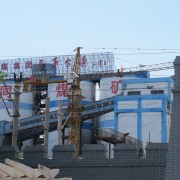Energy Intensive Industries, Energy Efficiency and Workers
China has many energy intensive industries. These industries play an important part in China’s economy, contribute significantly to China’s overall energy consumption, and also to China’s CO2 emissions. Important industries and sectors in this respect include: mining, metallurgy, cement, air conditioning, buildings, manufacturing and transport. However, recent years have also seen major and extremely impressive, reductions in the energy intensity of the economy, and also the introduction of important energy efficiency measures. Although energy intensity per unit of GDP has been substantially reduced, the overall energy production and consumption continues to rise rapidly. The demand for energy intensive industries, such as steel or cement, continually rises. This is a big contradiction.
Historically, many of China’s industries have quite an inefficient use of energy in production. This means that for questions of economic profitability as well as for international/national climate change commitments, there is a great motivation to increase energy efficiency and reduce energy consumption. Consequently, this is major component of the government’s long term industrial, energy, and climate strategy. Important gains have been made through the targeting of specific industrial sectors which are energy intensive. In particular, this includes, coal mining and power plants, steel, construction, cement and concrete, as well as domestic appliances such as air conditioners. There have also been important efforts within the transport sector. Within these sectors, the most energy consuming enterprises have been specifically targeted for reduction. In particular, the 1000 biggest energy consumers and emitters have been identified and targeted. Interventions are guided by overall policies from central government, whose implementation is then negotiated between local governments and the companies. While most of the efforts to reduce energy consumption has been to focus on reducing consumption in industry, domestic energy consumption has also been targeted. An important issue here is that in order to meet ambitious targets, there have been planned and regulated limited duration shut-offs of domestic electricity supply.
The implementation of has been different in the different sectors. For instance, in construction there are initial discussions of “energy efficient buildings”, while in relation to coal small thermal generation plants have been closed. Varying degrees of success have been met in different industries and in different geographical locations. A common feature across the different sectors is that frequently implementation has involved closing down many of the smaller companies, allowing consolidation into larger ones (both state owned enterprises and private, depending on the sector), as the larger companies are able to produce more efficiently. In addition to increasing efficiency, there has been concentration in the sector.
The energy intensive industries are also large employers of workers. There is an important relation between energy consumption and human labour, as mechanization and automation replace human labour with external energy inputs. Historically, in many countries, such as the UK, USA, and South Africa, the rising cost of labour as well as worker struggles, have been important factors in increasing levels of energy consumption in industry. It is important, though perhaps difficult, to consider the linkages between industrial energy consumption in China and the regulation of its workforce. Importantly, in recent years there have also been some significant conflicts involving workers in energy intensive sectors.

